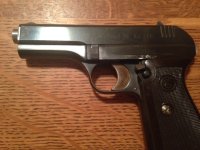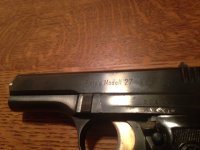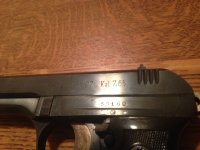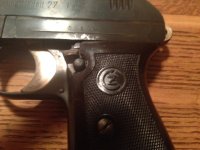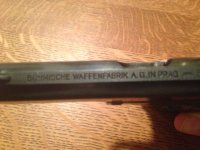I erred in stating that the CZ 27 was not produced prior to the German occupation, but only about 15,000 were made prior to the takeover. The CZ 24 (Vz 24, in 9mm Short) continued in production through most of that period for the Czech Army and police. In the last year or so, the CZ 38 (the so-called "Czech P-38", also in 9mm Short) was produced for the Czech army, but it was also dropped in favor of the CZ 27 after the German occupation. Both guns were taken over and used by the German police but none were made after the occupation because of the ammunition situation.
Some CZ 27's are seen with both Czech (top of slide) and German (left side) markings. Those may have been in factory stock at the time of the occupation so the original marking was left alone and the new one added.
After the German takeover (which was in two stages) the CZ 24 was dropped entirely and all production concentrated on the CZ 27 or P.27(t) in the German nomenclature. The major reason was that the 9mm Short (.380 ACP) was not in the German military or police supply system, the same reason the Hungarian Model 37 was converted to 7.65 for sale to the Germans.* (Of course a German may have been able to obtain commercial ammunition, but he would have had to buy it, not just go to his supply room.)
In response to another poster, CZ 27's with German markings but without the Waffenamt (Weapons Office) acceptance stamp were for police use.
Jim
*Unlike Belgium, France, Czechoslovakia, etc., Hungary was not an occupied country. It was an ally of Germany almost to the end of the war, and sale of Hungarian arms to Germany was a straight commercial proposition.
JK

